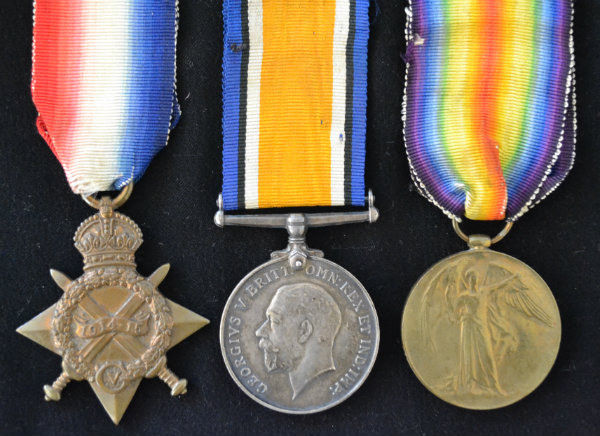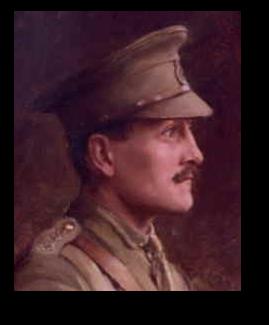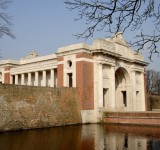Personal Details
Lord Hugh William Grosvenor born in London in 1884, the eighth son of the late Hugh Lupus Grosvenor, 1st Duke of Westminster and the eldest son with his second wife Katherine, Duchess of Westminster. The family home was Eaton Hall, Chester; the Duchess was living at Combermere Abbey, Burleydam, Cheshire at the time of Hugh’s death.
Husband of Mabel Florence Mary, Lady Hugh Grosvenor (nee Crichton) and father to Gerald Hugh and Robert George.
Hugh is also commemorated in the Grosvenor Chapel, St Mary’s Church, Eccleston, Chester.
Hugh’s brother in law Viscount Crichton was killed on the following day.
Military Details
Regiment : 1st Life Guards
Rank : Captain
Service Number :
Killed in action; Belgium 30 October 1914 Aged 30

The 1914 Star (also known as 'Pip') was authorised under Special Army Order no. 350 in November 1917 and by an Admiralty Fleet Order in 1918, for award to officers and men of the British and Indian Expeditionary Forces who served in France or Belgium between 5 August and midnight of 22–23 November 1914. The former date is the day after Britain's declaration of war against the Central Powers, and the closing date marks the end of the First Battle of Ypres.
The 1914–15 Star (also known as 'Pip') was instituted in December 1918 and was awarded to officers and men of British and Imperial forces who served against the Central European Powers in any theatre of the Great War between 5 August 1914 and 31 December 1915. The period of eligibility was prior to the introduction of the Military Service Act 1916, which instituted conscription in Britain.
The British War Medal (also known as 'Squeak') was a silver or bronze medal awarded to officers and men of the British and Imperial Forces who either entered a theatre of war or entered service overseas between 5th August 1914 and 11th November 1918 inclusive. This was later extended to services in Russia, Siberia and some other areas in 1919 and 1920. Approximately 6.5 million British War Medals were issued. Approximately 6.4 million of these were the silver versions of this medal. Around 110,000 of a bronze version were issued mainly to Chinese, Maltese and Indian Labour Corps. The front (obv or obverse) of the medal depicts the head of George V. The recipient's service number, rank, name and unit was impressed on the rim.
The Allied Victory Medal (also known as 'Wilfred') was issued by each of the allies. It was decided that each of the allies should each issue their own bronze victory medal with a similar design, similar equivalent wording and identical ribbon. The British medal was designed by W. McMillan. The front depicts a winged classical figure representing victory. Approximately 5.7 million victory medals were issued. Interestingly, eligibility for this medal was more restrictive and not everyone who received the British War Medal ('Squeak') also received the Victory Medal ('Wilfred'). However, in general, all recipients of 'Wilfred' also received 'Squeak' and all recipients of The 1914 Star or The 1914/1915 Star (also known as 'Pip') also received both 'Squeak' and 'Wilfred'. The recipient's service number, rank, name and unit was impressed on the rim.
Further Information
Lord Grosvenor is now assumed to have been killed in action on 30 October 1914. However, his death was not formally reported at the time and it was not until 1919 that his death was accepted and probate was granted for his estate. The following three newspaper articles highlight this five year period:
Report in the Bury Free Press surmising that Lord Grosvenor had been taken prisoner
"HOW LORD HUGH GROSVENOR WAS WOUNDED AND CAPTURED
As there has been some difference in the accounts of how Lord Hugh Grosvenor, 1st Life Guards, was wounded and taken prisoner during the close of the fighting on the Aisne, the following account, given by an eye witness, may be interesting. On the day of the action in which the matter took place, a British infantry detachment in the trenches was being badly punished by the German guns. The infantry could not go forward and they would not go back, so a diversion was necessary. The Royal Horse Guards, 2nd Life Guards, and the 1st Life Guards in the order named were supporting the British guns at the rear of the trenches - the guns being two batteries of Royal Horse Artillery. The cavalry moved to the right flank of the trenches and under cover of a wood formed up - the Blues leading - to gallop across the front to the German guns and so draw their fire. The three regiments galloped across the guns, which opened on them. The Blues being in front got off comparatively easy, the 2nd Life Guards got it heavier and the 1st Life Guards bringing up the rear got it very hard. Lord Hugh Grosvenor was riding in front of his squadron when a shrapnel shell brought down his horse and wounded him in the leg. He made an attempt to get another horse, but failed. In the meantime the cavalry had swept on to the other flank and the infantry taking advantage of the diversion rapidly rushed to either flank and carried the German guns - five in all - with the bayonet. Subsequently when the ground was searched for our wounded Lord Hugh Grosvenor was reported missing and it was surmised that some of the German skirmishers had carried him off."
Bury Free Press 23 January 1915
Report in the Nantwich Guardian of the efforts being made by Lord Grosvenor's mother to establish his whereabouts
"Katherine Duchess of Westminster is untiring in her inquiries about her son, Lord Hugh Grosvenor and her son-in-law, the Earl of Erne, both of whom have been missing for some months after having taken part in engagements in France. Last week she visited a corporal-of-horse in Captain Lord Hugh's squadron of the 1st Life Guards. This man claims to have seen Lord Hugh wounded when his squadron was forced to retire on October 31st, when the Germans were making their desperate rush for Calais. This goes a little farther beyond what was already known and furnishes more hopeful probabilities."
Nantwich Guardian 15 October 1915
Report in the Sheffield Independent 27 March 1919 finally confirming Lord Grosvenor's death
"OCTOBER '14 TO MARCH '19
Lady Hugh Grosvenor whose husband's death is now officially concluded to have taken place in October 1914, when he was listed as 'missing' along with her brother, Lord Crichton, had long ago abandoned all hope of his being alive. In October 1917, as nothing had been heard of him, Lady Hugh after three years of anxiety, was reluctantly compelled to believe he was no more. She then resigned his prospective candidature for Macclesfield. He was the Duke of Westminster's step-uncle."
Sheffield Independent 27 March 1919
Taken from Forces War Records
If you can provide any further information on Lord Hugh William Grosvenor please get in touch by leaving a comment below, using our Contact Form or by calling in to Whitchurch Heritage Centre.
Information provided by Whitchurch Museum and Archives


